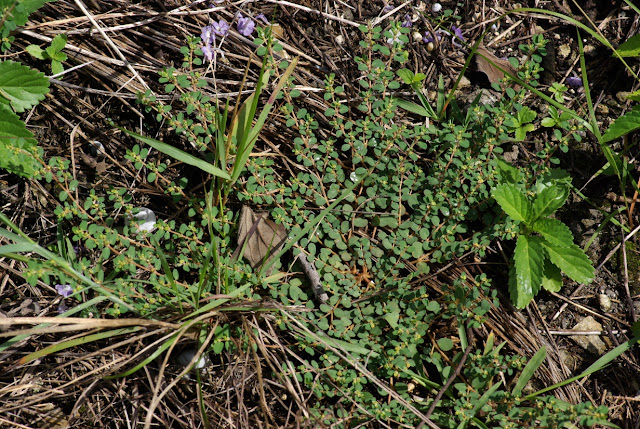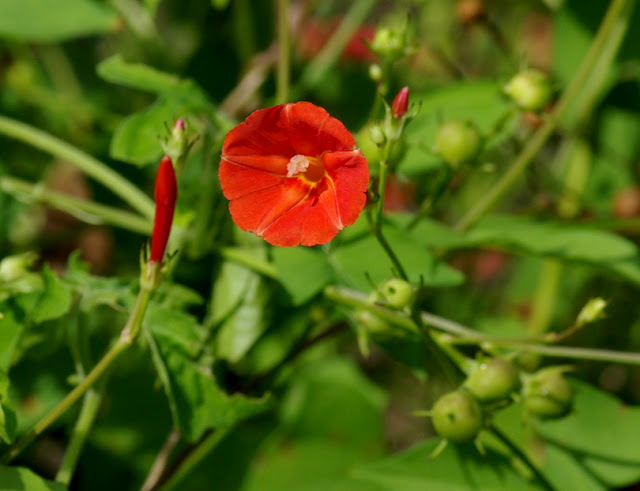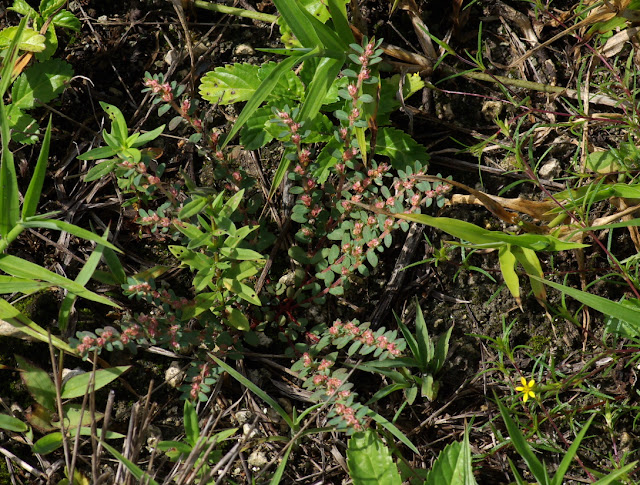This is the third part of a four-part series of blog posts on a short botanical field trip to south Florida.
Our second stop of the field trip was right-of-way road along a canal that had been cut through lime rock. This did not seem like a particular interesting site but it turned out to have a wide variety of grasses, sedges, small herbaceous wildflowers, assorted vines, and various woody plants. And, in a dark, shady spot where a few trees had formed a small grove, Michael Manna found Adiantum tenerum, a native maidenhair fern.
 |
| The right-of-way road of a canal was our second stop. |
A variety of Euphorbia species were easily seen at this site, including the common and weedy wild poinsettia, Euphorbia cyathophora. Wild poinsettia is very easily grown in any moist to dry lightly shaded to sunny spot but it is remarkably weedy in garden settings and I have had occasions where literally several hundred plants were growing in my garden at one time. They are pretty enough when in full flower but they are annuals and are decidedly less attractive as they slowly decline as they go to seed.
 |
| The narrow leaf form of wild poinsettia, Euphorbia cyathophora (synonym: Poinsettia cyathophora). |
 |
| The broad leaf form of Euphorbia cyathophora is so distinct as to appear to be a different species but every gradation between narrow leaf and broad leaf forms can be found in nature. |
I am inordinately fond of sandmat Euphorbia species, which were formerly referred to the segregate genus, Chamaesyce. So I could barely contain my excitement to see that the state-listed endangered plant, Euphorbia conferta was common at this site. It was joined by Euphorbia mendezii, a plant that, at least in south Florida, commonly occurs in disturbed rocky areas. And a third sandmat Euphorbia species (pictured below) was new to me. It was unusual in forming a rounded mat of prostrate stems with a perimeter of ascending flowering stems.
 |
| Euphorbia conferta covered by shallow water that has accumulated in a shallow depression in the lime rock after a rain storm. |
 |
| An unidentified Euphorbia species. |
Completely new to both me and Michael Manna was Tournefortia volubilis, an unusual woody vine in the borage family with tiny yellow-green flowers. It would be interesting to see what pollinates such unusual little flowers. The fruits are pea-sized white berries with two, or sometimes three, conspicuous purplish-black or black spots.
 |
| Tournefortia volubilis |
In one area, there was a thick growth of Ipomoea hederifolia, an annual or short-lived vine sometimes grown in butterfly or hummingbird gardens for its showy, eye-catching orange or orange-red flowers. But it should not be introduced into small, tidy gardens since it produces numerous, rather unattractive seed capsules and, if conditions are to its liking, it can produce hundreds of self-sown seedlings and can overrun the garden.
 |
| Ipomoea hederifolia |
We also saw Cissus verticillata, in the grape family (Vitaceae), growing in thickets. It is fairly uncommon in Palm Beach County but was rather common throughout our field trip and, later in the day, we saw it along roadsides as well as climbing fences around avocado groves.
 |
| Cissus verticillata |
Although the vines were interesting and not something we see every day in Palm Beach County, it was the abundant and varied grasses, sedges, and small wildflowers that most held my attention and the next three images are but a sample of the variety of small herbaceous plants that we found along the canal right-of-way road.
 |
| Stachytarpheta jamaicensis, the native blue porterweed, was rather inconspicuous but common throughout the site. |
 |
| An unidentified member of the hibiscus family (Malvaceae) growing with a few of the many species of grasses found along the canal right-of-way. |
Go to Part 1 of a "South Florida Field Trip."
Go to Part 2 of a "South Florida Field Trip."
Go to Part 4 of a "South Florida Field Trip."
Go to Part 2 of a "South Florida Field Trip."
Go to Part 4 of a "South Florida Field Trip."
Image and text © 2012 Rufino Osorio



No comments:
Post a Comment